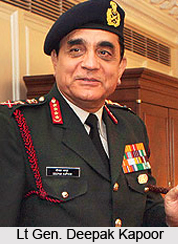 Lt General Deepak Kapoor is the 25th Chief of Army Staff of India. He was appointed on 30th September, 2007. He was the Chairman, Chiefs of Staffs Committee (COSC) and was appointed on 31 August 2009. He retired on 31st March, 2010. He was born in the year 1948. He joined into the Regiment of Artillery on June 11, 1967 when he was 21 years old. He was the student of Defence Services Staff College in Wellington. He also took training from National Defence College. He did his masters in Business Administration, Political Science and Military Science. His career in Indian Army spanned over four decades.
Lt General Deepak Kapoor is the 25th Chief of Army Staff of India. He was appointed on 30th September, 2007. He was the Chairman, Chiefs of Staffs Committee (COSC) and was appointed on 31 August 2009. He retired on 31st March, 2010. He was born in the year 1948. He joined into the Regiment of Artillery on June 11, 1967 when he was 21 years old. He was the student of Defence Services Staff College in Wellington. He also took training from National Defence College. He did his masters in Business Administration, Political Science and Military Science. His career in Indian Army spanned over four decades.
Career of Lt Deepak Kapoor
During the war against Pakistan in 1971 he was very dynamic. He also served as the Chief Operations Officer of the UN Peacekeeping Mission in Somalia from 1994 to 1995. He was honoured the Vishisht Seva Medal in January 1996 for leading all United Nations troops deployed in Somalia. General Kapoor served as a Brigade Commander and was deployed on the Line of Control in Jammu and Kashmir. During the Operation Parakram, he commanded one of the most prestigious divisions of the Indian Army. (RAM Division as part of a Strike Corps). He was also the commander -in -chief of the largest and the most sensitive troops in the North East, along the India-China border for a year. He commanded 4 Corps in the North East; fighting uprising in Assam and subsequently he led 33 Corps, positioned on the India-China border. As an Army Commander, he commanded the Army Training Command at Shimla.
Awards of Lt Deepak Kapoor
For his performance the Government of India awarded the Sena Medal to General Kapoor in January 1998. In 2006 General Kapoor was awarded Ati Vishisht Seva Medal for his outstanding command of the Corps. General Deepak Kapoor was awarded the Param Vishist Seva Medal in January 2007.
Personal Life of Lt Deepak Kapoor
The General is married to Mrs Kirti, daughter of an army expert, Brig KP Pande, who is a recipient of Maha Vir Chakra. Kapoors have a daughters and a son, and are both married.




















